Experts in architecture and environmental health recently gathered to discuss the relationship between buildings and health in the seventh episode of the Sika Challenge 30/50 podcast. Sika, a company committed to innovation and the safety of its products, highlighted the minimization of volatile organic compounds (VOCs) and the improvement of indoor air quality in both renovated and new buildings.
“After the COVID-19 pandemic, people’s way of life and work has changed significantly, and buildings must adapt to these new needs,” said the experts from Sika, the General Council of Technical Architecture of Spain (CGATE), the Efficient Habitat Cluster AEICE, and the Green Building Council Spain (GBCe) during the episode recording.
One of the most relevant topics discussed was indoor air quality. According to the World Health Organization (WHO), indoor air pollution can be up to five times higher than outdoor pollution. Juan López-Asiain, director of the Technical Office of CGATE, pointed out that “something as simple as sleeping with the door closed can multiply the concentration of CO₂ in a room, affecting the breathing and rest of the inhabitants.” Additionally, the importance of the healthiness of construction materials and the need to renovate old buildings to meet modern standards of well-being and environmental health were addressed.
Dolores Huerta, general director of GBCe, emphasized the impact of materials on physical and psychological health: “People spend 80% of their time indoors. The influence of the environment on health is very high and not always consciously understood.”
Addressing the incidence of unhealthy materials in buildings is crucial to ensuring safe and healthy environments. Julia Gómez, from Sika’s prescription department, emphasized: “We work to make materials as healthy as possible, from production to their application and use in buildings. We have a list of hazardous materials that is more restrictive than official regulations and sets the path to create more sustainable and less harmful products for health.”
Sika has implemented measures to minimize VOCs in its products. Gómez explained that they pre-polymerize the bisphenols in resins to prevent them from being released as volatiles and prioritize polyolefin sheets (FP) in roof waterproofing. Additionally, she highlighted the importance of safety data sheets to understand the risks associated with the materials used.
The renovation of old buildings, such as those built in the 1980s, is also essential to avoid unhealthy conditions. López-Asiain stated, “Buildings from that era, built before current regulations, require comprehensive renovation to meet modern standards of comfort and health.”
Enrique Cobreros, director of AIECE, pointed out that “both the sector and Spain have a challenge, which is to meet the goals set by the European Union and the Long-Term Strategy for Energy Renovation in the Building Sector in Spain (ERESE).” López-Asiain added the need to focus efforts on renovation to improve quality of life in the environments where most time is spent.
The full debate among experts can be heard on the Sika Challenge 30/50 podcast, available on Spotify, Ivoox, and other platforms, addressing the challenges of meeting the 30/50 Agenda.
Referrer: MiMub in Spanish











